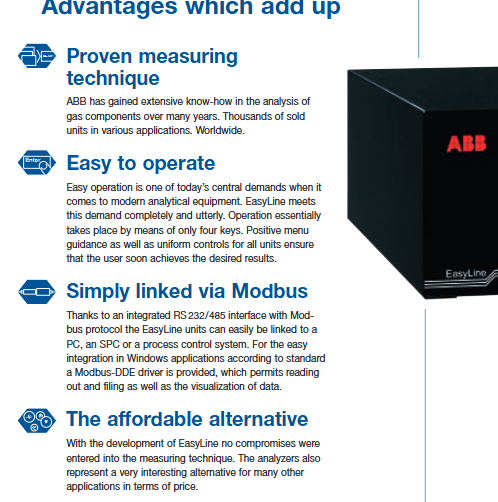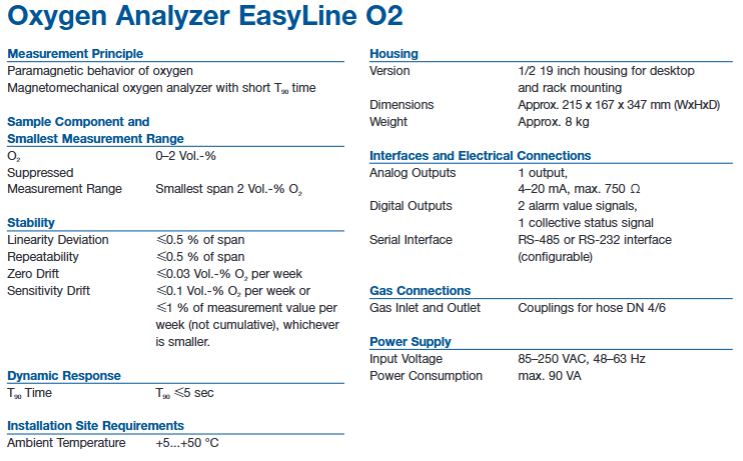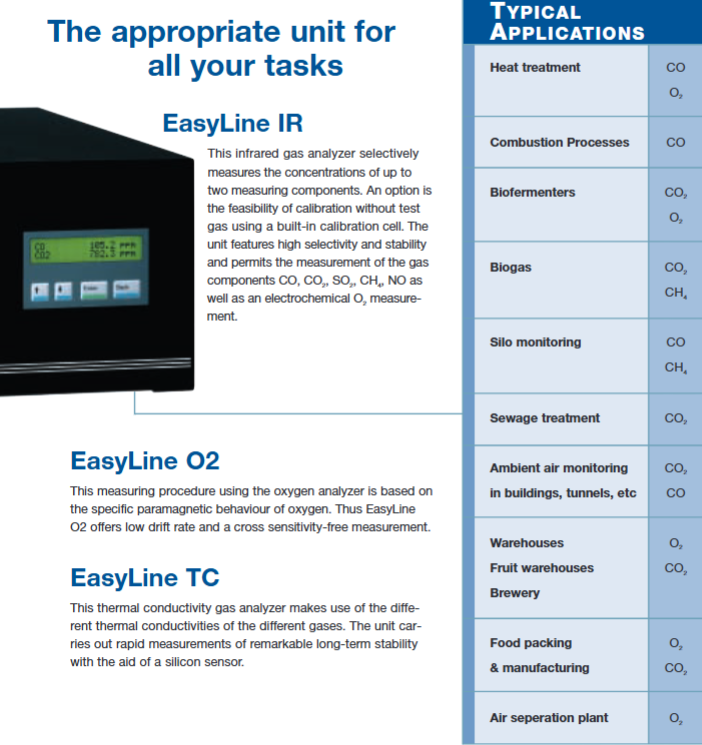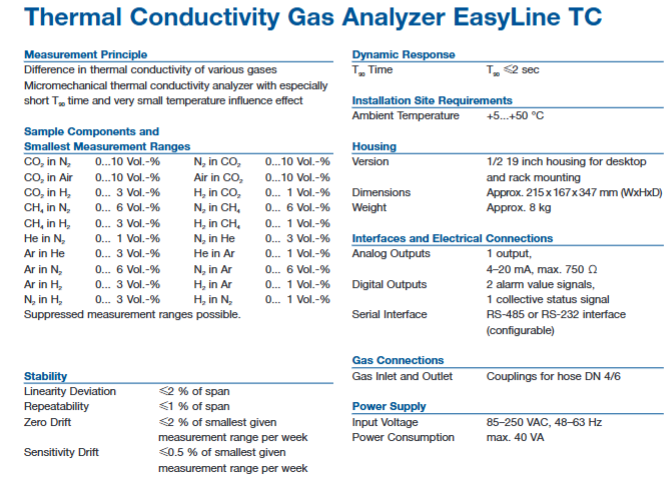

K-WANG


ABB EasyLine series gas analyzer
Mature technology: Based on ABB's years of experience in gas composition analysis, the product technology is mature and has been widely applied worldwide.
Easy to operate: Basic operations can be achieved through 4 buttons, menu navigation is clear, and all device control methods are unified, making it easy for users to quickly get started.
Easy to connect: Integrated with RS 232/485 interface and supporting Modbus protocol, it can easily connect with computers, SPC or process control systems. It also provides Modbus DDE driver for easy data reading, storage and visualization in Windows applications.
High cost-effectiveness: With competitive prices while ensuring that measurement technology is not discounted, it is an economical choice for various application scenarios.
ABB EasyLine series gas analyzer
Product positioning and core advantages
EasyLine is a new gas concentration monitoring equipment series launched by ABB, aimed at providing simple, economical, and reliable gas analysis solutions for various application scenarios. Its core advantages include:
Mature technology: Based on ABB's years of experience in gas composition analysis, the product technology is mature and has been widely applied worldwide.
Easy to operate: Basic operations can be achieved through 4 buttons, menu navigation is clear, and all device control methods are unified, making it easy for users to quickly get started.
Easy to connect: Integrated with RS 232/485 interface and supporting Modbus protocol, it can easily connect with computers, SPC or process control systems. It also provides Modbus DDE driver for easy data reading, storage and visualization in Windows applications.
High cost-effectiveness: With competitive prices while ensuring that measurement technology is not discounted, it is an economical choice for various application scenarios.

Main product models and technical parameters
Oxygen analyzer (EasyLine O ₂)
Measurement principle: Based on oxygen paramagnetism, using magneto mechanical principle, with short response time.
Measurement range: The minimum measurement range is O ₂ 0-2 Vol. -%, supporting a suppression measurement range with a minimum span of 2 Vol. -% O ₂.
Stability: Linear deviation ≤ 0.5% of span, repeatability ≤ 0.5% of span, zero drift ≤ 0.03 Vol. -% O ₂/week, sensitivity drift ≤ 0.1 Vol. -% O ₂/week or ≤ 1% measurement value/week (whichever is smaller, not cumulative).
Dynamic response: T ₉₀ time ≤ 5 seconds.
Installation environment: ambient temperature+5...+50 ° C.
Equipment specifications: Adopting a 1/2 19 inch casing, supporting desktop and rack installation, with dimensions of approximately 215 x 167 x 347 mm (width x height x depth) and a weight of approximately 8 kg.
Interface and connection: 1 channel 4-20 mA analog output (maximum 750 Ω), 2 channels of alarm value signal and 1 channel of collective status signal digital output, supporting RS-485 or RS-232 interface (configurable).
Gas connection: The inlet and outlet ports are equipped with DN 4/6 hoses.
Power supply: Input voltage 85-250 VAC, 48-63 Hz, maximum power consumption 90 VA.

Infrared gas analyzer (EasyLine IR)
Measurement principle: Infrared photometer can measure 1 or 2 components. If used in conjunction with an electrochemical oxygen sensor, it can only measure 1 infrared gas component.
Measurement range: The measurable gases and minimum measurement range include CO 0... 500 ppm, CO ₂ 0... 500 ppm, SO ₂ 0... 500 ppm, CH ₄ 0... 500 ppm, NO 0... 1000 ppm. It can also be combined with O ₂ (0... 5 vol. -%) for measurement (specific combinations are shown in the document table).
Stability: Linear deviation ≤ 1% of span, repeatability ≤ 0.5% of span, zero drift ≤ 1% of span/week, sensitivity drift ≤ 1% of measured value/week.
Dynamic response: T ₉₀ time ≤ 2 seconds (O ₂ sensor ≤ 30 seconds).
Installation environment: ambient temperature+5 to+45 ° C (+5 to+40 ° C with O ₂ sensor).
Equipment specifications: Same as oxygen analyzer, 1/2 19 inch casing, size approximately 215 x 167 x 347 mm, weight approximately 8 kg.
Interface and Connection: Each sample component has 1 analog output and 2 digital outputs of alarm value signals, supporting RS-485 or RS-232 interfaces (configurable).
Gas connection: The inlet and outlet ports are equipped with DN 4/6 hoses.
Power supply: Input voltage 85-250 VAC, 48-63 Hz, maximum power consumption of 40 VA.
Thermal conductivity gas analyzer (EasyLine TC)
Measurement principle: Based on the difference in thermal conductivity of different gases, micro mechanical thermal conductivity analysis technology is used, which has a short response time and is less affected by temperature.
Measurement range: It can measure various gas combinations and the minimum measurement range, such as CO ₂ in N ₂ 0... 10 Vol. -%, CH ₄ in N ₂ 0... 6 Vol. -%, etc. (see document table for details), supporting suppression of measurement range.
Stability: Linear deviation ≤ 2% of span, repeatability ≤ 1% of span, zero drift ≤ 2% of minimum given measurement range/week, sensitivity drift ≤ 0.5% of minimum given measurement range/week.
Dynamic response: T ₉₀ time ≤ 2 seconds.
Installation environment: ambient temperature+5...+50 ° C.
Equipment specifications: Same as the two analyzers mentioned above, with a 1/2 19 inch casing, dimensions of approximately 215 x 167 x 347 mm, and a weight of approximately 8 kg.
Interface and connection: 1 channel 4-20 mA analog output (maximum 750 Ω), 2 channels of alarm value signal and 1 channel of collective status signal digital output, supporting RS-485 or RS-232 interface (configurable).
Gas connection: The inlet and outlet ports are equipped with DN 4/6 hoses.
Power supply: Input voltage 85-250 VAC, 48-63 Hz, maximum power consumption of 40 VA.

Typical application scenarios
This series of analyzers is widely used, including but not limited to:
Heat treatment (CO, O ₂)
Combustion process (CO)
Biological fermentation tank (CO ₂, O ₂)
Biogas (CO ₂, CH ₄)
Storage bin monitoring (CO, CH ₄)
Wastewater treatment (CO ₂)
Environmental air monitoring for buildings, tunnels, etc. (CO ₂ CO)
Warehouse, fruit warehouse, brewery (O ₂, CO ₂)
Food packaging and manufacturing (O ₂, CO ₂)
Air separation equipment (O ₂)

- YOKOGAWA
- Energy Access
- Renewable Integration
- Energy Subsidies
- Energy and Water
- Net zero emission
- Energy Security
- Critical Minerals
- A-B
- petroleum
- Mine scale
- Energy and Gender
- Covid-19
- man-machine
- Reliance
- ADVANCED
- SEW
- ProSoft
- WATLOW
- Kongsberg
- FANUC
- VSD
- DCS
- PLC
- Sewage treatment
- cement
- Yaskawa
- Woodward
- BOSCH Rexroth
- MOOG
- General Electric
- American NI
- Rolls-Royce
- CTI
- Honeywell
- EMERSON
- xYCOM
- Construction site
- Siemens
- architecture
- Industrial information
- New energy
- Automobile market
- electricity
- Motorola
- HIMA
- ABB
- Rockwell
- Schneider Modicon
- MAN
- GE
- TRICONEX
- Control Wave
- ALSTOM
- AMAT
- STUDER
- KONGSBERG
- MOTOROLA
- DANAHER MOTION
- Bentley
- Galil
- EATON
- MOLEX
- Triconex
- DEIF
- B&W
- ZYGO
- Aerotech
- DANFOSS
- KOLLMORGEN
- Beijer
- Endress+Hauser
- schneider
- Foxboro
- KB
- REXROTH
-
Kollmorgen S33GNNA-RNNM-00 - Brushless Servo Motor
-
Kollmorgen 6sm56-s3000-g-s3-1325 - Servo Motor
-
Kollmorgen AKM52K-CCCN2-00 - Servo Motor
-
Kollmorgen PSR3-230/75-21-202 - Power Supply
-
Kollmorgen akm24d-anc2r-00 - Servo Motor
-
Kollmorgen AKM22E-ANCNR-00 - Servo Motor
-
Kollmorgen S60300-550 - Servo Drive
-
Kollmorgen B-204-B-21 - Servomotor
-
Kollmorgen AKM21E-BNBN1-00 - Servo Motor
-
Kollmorgen TT2953-1010-B - DC Servo Motor
-
Kollmorgen pa8500 - Servo Power Supply
-
Kollmorgen BDS4A-210J-0001-207C2 - Servo Drive
-
Kollmorgen TTRB1-4234-3064-AA - DC Servo Motor
-
Kollmorgen MH-827-A-43 - Servo Motor
-
Kollmorgen AKM24D-ACBNR-OO - Servo Motor
-
Kollmorgen 00-01207-002 - Servo Disk DC Motor
-
Kollmorgen AKM21C-ANBNAB-00 - Servo Motor
-
Kollmorgen PSR3-208/50-01-003 - Power Supply
-
Kollmorgen 6SM56-S3000 - Servo Motor
-
Kollmorgen DBL3H00130-B3M-000-S40 - Servo Motor
-
Kollmorgen 6SN37L-4000 - Servo Motor
-
Kollmorgen AKM65K-ACCNR-00 - Servo motor
-
Kollmorgen 6SM56-L3000-G - Servo Motor
-
Kollmorgen AKMH43H-CCCNRE5K - Servo Motor
-
Kollmorgen PSR4/52858300 - Power Supply
-
Kollmorgen KBM-79H03-E03 - Direct Drive Rotary Motor
-
Kollmorgen AKM33E-ANCNDA00 - Servo Motor
-
Kollmorgen U9M4/9FA4T/M23 - ServoDisc DC Motor
-
Kollmorgen AKM13C-ANCNR-00 - Servo Motor
-
Kollmorgen AKM43L-ACD2CA00 - Servo Motor
-
Kollmorgen AKM54K-CCCN2-00 - Servo Motor
-
Kollmorgen M-605-B-B1-B3 - Servo Motor
-
Kollmorgen AKD-P00606-NBAN-0000 - Rotary Drive
-
Kollmorgen 6SM-37M-6.000 - Servo Motor
-
Kollmorgen A.F.031.5 - Sercos Interface Board
-
Kollmorgen 918974 5054 - Servo PWM
-
Kollmorgen U12M4 - ServoDisc DC Motor
-
Kollmorgen AKD-B00606-NBAN-0000 - Servo Drive
-
Kollmorgen MV65WKS-CE310/22PB - Servo Drive
-
Kollmorgen 65WKS-CE310/22PB - Servo Drive
-
Kollmorgen EM10-27 - Module
-
Kollmorgen S64001 - Servo Drive
-
Kollmorgen CR03200-000000 - Servo Drive
-
Kollmorgen 6SM57M-3000+G - Servo Motor
-
Kollmorgen BDS4 - Servo Drive
-
Kollmorgen AKD-P00306-NBEC-000 - Servo Drive
-
Kollmorgen AKD-B01206-NBAN-0000 - Servo Drive
-
Kollmorgen STP-57D301 - Stepper Motor
-
Kollmorgen 6SM37L-4.000 - Servo Motor
-
Kollmorgen 44-10193-001 - Circuit Board
-
Kollmorgen PRDR9SP24SHA-12 - Board
-
Kollmorgen PRD-AMPE25EA-00 - Servo Drive
-
Kollmorgen DBL3N00130-0R2-000-S40 - Servo Motor
-
Kollmorgen S406BA-SE - Servo Drive
-
Kollmorgen AKD-P00607-NBEI-0000 - Servo Drive
-
Kollmorgen AKD-P01207-NBEC-0000 - Servo Drive
-
Kollmorgen CR03550 - Servo Drive
-
Kollmorgen VSA24-0012/1804J-20-042E - Servo Drive
-
Kollmorgen N2-AKM23D-B2C-10L-5B-4-MF1-FT1E-C0 - Actuator
-
Kollmorgen 04S-M60/12-PB - Servo Drive
-
Kollmorgen H33NLHP-LNW-NS50 - Stepper Motor
-
Kollmorgen A-78771 - Interlock Board
-
Kollmorgen AKM43E-SSSSS-06 - Servo Motor
-
Kollmorgen AKD-P00607-NBEC-0000 - Servo Drive
-
Kollmorgen E21NCHT-LNN-NS-00 - Stepper Motor
-
Kollmorgen cr10704 - Servo Drive
-
Kollmorgen d101a-93-1215-001 - Motor
-
Kollmorgen BDS4A-203J-0001-EB202B21P - Servo Drive
-
Kollmorgen MCSS23-6432-002 - Connector
-
Kollmorgen AKD-P01207-NACC-D065 - Servo Drive
-
Kollmorgen CK-S200-IP-AC-TB - I/O Adapter and Connector
-
Kollmorgen CR10260 - Servo Drive
-
Kollmorgen EC3-AKM42G-C2R-70-04A-200-MP2-FC2-C0 - Actuator
-
Kollmorgen BDS5A-206-01010-205B2-030 - Servo Drive
-
Kollmorgen s2350-vts - Servo Drive
-
Kollmorgen AKM24D-ANC2DB-00 - Servo Motor
-
Kollmorgen E31NCHT-LNN-NS-01 - Stepper Motor
-
Kollmorgen PRD-0051AMPF-Y0 - Servo Board
-
Kollmorgen TB03500 - Module
-
Kollmorgen 60WKS-M240/06-PB - Servo Drive
-
Kollmorgen M21NRXC-LNN-NS-00 - Stepper Motor
-
Kollmorgen H-344H-0212 - Servo Motor
-
Kollmorgen MCSS08-3232-001 - Connector
-
Kollmorgen AKM33H-ANCNC-00 - Servo Motor
-
Kollmorgen PA-2800 - Power Supply
-
Kollmorgen MTC308C1-R1C1 - Servo Motor
-
Kollmorgen PRDR0091300Z-00 - Capacitor Board
-
Kollmorgen BDS4A-206J-0024/01502D79 - Servo Drive
-
Kollmorgen S20330-VTS - Servo Drive
-
Kollmorgen S20250-CNS - Servo Drive
-
Kollmorgen SBD2-20-1105-WO - Servo Drive Board
-
Kollmorgen M405-C-A1--E1 - Servo Motor
-
Kollmorgen PRD-PB805EDD-00 - Servo Drive
-
Kollmorgen 6SM57S-3.000-J-09-HA-IN - Servo Motor
-
Kollmorgen AKM33H-ANCNDA-00 - Servo Motor
-
Kollmorgen PCB-00030200-04 - PCB
-
Kollmorgen H22SSLB-LNN-NS-02 - Stepper Motor
-
Kollmorgen BJRL-20012-110001 - Module
-
Kollmorgen BDS4A-206J-0001404A - Servo Drive
-
Kollmorgen H-342-H-0802 - Servo Motor
-
Kollmorgen CR10561 - Servo Drive
-
Kollmorgen BDS5A-206-00010-205B2-030 - Servo Drive
-
Kollmorgen BDS5A-206-00010-207B-2-030 - Servo Drive
-
Kollmorgen mcss08-3224-001 - Connector
-
Kollmorgen M-207-B-23-B3 - Servo Motor
-
Kollmorgen PRD-0041200Z-S0 - Encoder/Resolver Card
-
Kollmorgen MH-225-G-61 - Motor
-
Kollmorgen MT308B1-T1C1 - Servo Motor
-
Kollmorgen BDS4A-240J-0001604C83 - Servo Drive
-
Kollmorgen 6SM57-S-3000 - Servo Motor
-
Kollmorgen N-T31V-15-5B-6-MF3-FT1E-C251 - Actuator
-
Kollmorgen PRD-0051AMPA-X0 - Servo Board
-
Kollmorgen CF-SS-RHGE-09 - Cable
-
Kollmorgen DIGIFAS7204 - Servo Drive
-
Kollmorgen S30101-NA - Servo Drive
-
Kollmorgen DIGIFAS7201 - Servo Drive
-
Kollmorgen PRD-0051AMPA-Y0 - Servo Board
-
Kollmorgen AKM23D-EFCNC-00 - Servo Motor
-
Kollmorgen SE10000 - Servo Drive
-
Kollmorgen PSR4/5A-112-0400 - Power Supply
-
Kollmorgen AKM31H-ANCNC-01 - Servo Motor
-
Kollmorgen M-203-B-93-027 - Servo Motor
-
Kollmorgen CP-SS-G1HE-05 - Connector
-
Kollmorgen AKM42G-ASCNR-02 - Servo Motor
-
Kollmorgen DBL4N00750-B3M-000-S40 - Servo Motor
-
Kollmorgen R3-BK23-152B-12-PL-ASE-BS115 - Actuator
-
Kollmorgen MH-427-B-61 - Motor
-
Kollmorgen cr06902 - Servo Drive




